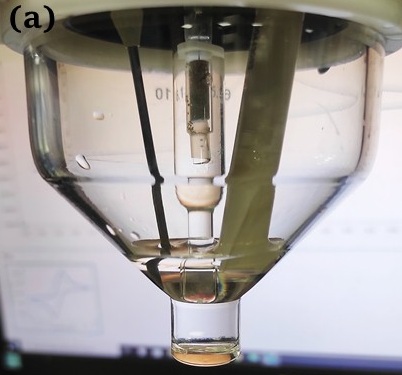
Electrochemical behavior of chloramphenicol on carbon electrodes in a microelectrochemical cell
Abstract
Keywords
Full Text:
PDFReferences
Bai X, Qin C, Huang X. Voltammetric determination of chloramphenicol using a carbon fiber microelectrode modified with Fe3O4 nanoparticles. Microchim Acta. 2016;183(11):2973–2981. doi:10.1007/s00604-016-1945-x
Zaidi SA. Recent advancement in various electrochemical and immunosensing strategies for detection of chloramphenicol. Int J Electrochem Sci. 2013;8(7):9936–9955.
Viñas P, Balsalobre N, Hernández-Córdoba M. Determination of chloramphenicol residues in animal feeds by liquid chromatography with photo-diode array detection. Anal Chim Acta. 2006;558(1–2):11–15. doi:10.1016/j.aca.2005.10.059
AlAani H, Alnukkary Y. Stability-indicating HPLC method for simultaneous determination of chloramphenicol, dexamethasone sodium phosphate and tetrahydrozoline hydrochloride in ophthalmic solution. Adv Pharm Bull. 2016;6(1):137–141. doi:10.15171/apb.2016.020
Naik SD, Nagaraja P, Yathirajan HS, Hemanthakumar MS, Mohan BM. New spectrophotometric methods for the quantitative determination of chloramphenicol in pharmaceuticals. Pharm Chem J. 2006;40(10):576–581. doi:10.1007/s11094-006-0197-1
Kucharska U, Leszczynska J. The use of ELISA method for the determination of chloramphenicol in food products of animal origin. Chem Listy. 2000;94(3):190–194.
Qu F, Li NB, Luo HQ. Highly sensitive fluorescent and colorimetric pH sensor based on polyethylenimine-capped silver nanoclusters. Langmuir. 2013;29(4):1199–1205. doi:10.1021/la304558r
Chuanuwatanakul S, Chailapakul O, Motomizu S. Electrochemical analysis of chloramphenicol using boron-doped diamond electrode applied to a flow-injection system. Anal Sci. 2008;24(4):493–498. doi:10.2116/analsci.24.493
Hue NT, Pham TN, Dinh NX. et al. AuNPs-modified screen-printed electrodes (SPCE and SPPtE) for enhanced direct detection of chloramphenicol. J Electron Mater. 2022;51:1669–1680. doi:10.1007/s11664-022-09434-9
Pakapongpan S, Poo-arporn Y, Tuantranont A, Poo-arporn RP. A facile one-pot synthesis of magnetic iron oxide nanoparticles embed N-doped graphene modified magnetic screen printed electrode for electrochemical sensing of chloramphenicol and diethylstilbestrol. Talanta. 2022;241. doi:10.1016/j.talanta.2021.123184
Li J, Bo X. Laser-enabled flexible electrochemical sensor on finger for fast food security detection. J Hazard Mater. 2022;423. doi:10.1016/j.jhazmat.2021.127014
Metters JP, Kadara RO, Banks CE. New directions in screen printed electroanalytical sensors: An overview of recent developments. Anal. 2011;136(6):1067–1076. doi:10.1039/c0an00894j
Porada R, Jedlińska K, Lipińska J, Baś B. Review – voltammetric sensors with laterally placed working electrodes: A review. J Electrochem Soc. 2020;167(3). doi:10.1149/1945-7111/ab64d6
Matemadombo F, Apetrei C, Nyokong T, Rodríguez-Méndez ML, De Saja JA. Comparison of carbon screen-printed and disk electrodes in the detection of antioxidants using CoPc derivatives. Sens Actuators B Chem. 2012;166–167:457–466. doi:10.1016/j.snb.2012.02.088
Hussain G, Silvester DS. Comparison of voltammetric techniques for ammonia sensing in ionic liquids. Electroanal. 2018;30(1):75–83. doi:10.1002/elan.201700555
Farhana Roslan NA, Rahim RA, Md Ralib AA, Za’bah NF, Nordin AN, Riza Bashri MS, Suhaimi MI, Samsudin Z, Ming LL, Sugandi G. Simulation of geometrical parameters of screen printed electrode (SPE) for electrochemical-based sensor. Proc 2021 IEEE Reg Symp Micro Nanoelectron RSM. 2021:137–140. doi:10.1109/RSM52397.2021.9511577
Prasek J, Trnkova L, Gablech I, Businova P, Drbohlavova J, Chomoucka J, Adam V, Kizek R, Hubalek J. Optimization of planar three-electrode systems for redox system detection. Int J Electrochem Sci. 2012;7(3):1785–1801.
Bard AJ, Faulkner LR. Electrochemical Methods: Fundamen-tals and Applications. 2nd ed. New York: John Wiley & Sons; 2001. 833 p.
Ivoilova AV, Mikhal’chenko LV, Tsmokalyuk AN, Kozitsina AN, Ivanova AV, Rusinov VL. Redox conversions of new antiviral drug triazavirin®: Electrochemical study and ESR spectroscopy. Russ Chem Bull. 2021;70(6):1099–1108. doi:10.1007/s11172-021-3190-7
DOI: https://doi.org/10.15826/chimtech.2022.9.4.09
Copyright (c) 2022 Tatiana S. Svalova, Regina A. Zaidullina, Margarita V. Medvedeva, Elizaveta D. Vedernikova, Alisa N. Kozitsina

This work is licensed under a Creative Commons Attribution 4.0 International License.
Chimica Techno Acta, 2014–2025
eISSN 2411-1414
Copyright Notice







